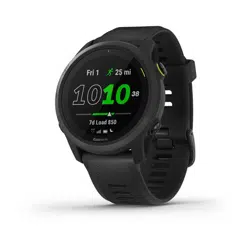Loading ...
Loading ...
Loading ...

Putting On the Heart Rate Monitor
You should wear the heart rate monitor directly on your skin, just below your sternum.
1 Select a strap extender for the best fit.
2 Wear the heart rate monitor with the Garmin logo facing right-side up.
The hook and loop connection should be on your right side.
3 Wrap the heart rate monitor around your chest, and connect the strap hook to the loop.
NOTE: Make sure the care tag does not fold over.
4 Tighten the heart rate monitor so it is snug around your chest, but not restrictive.
After you put on the heart rate monitor, it is active, storing, and sending data.
Tips for Using the HRM-Swim Accessory
• Adjust the tightness of the heart rate monitor and strap extender if the heart rate monitor slides down your
chest when pushing off the pool wall.
• Stand up between intervals so that the heart rate monitor is out of the water to see your heart rate data.
Running Dynamics
You can use your compatible Forerunner device paired with the HRM-Pro accessory or other running dynamics
accessory to provide real-time feedback about your running form.
The running dynamics accessory has an accelerometer that measures torso movement in order to calculate six
running metrics.
Cadence: Cadence is the number of steps per minute. It displays the total steps (right and left combined).
Vertical oscillation: Vertical oscillation is your bounce while running. It displays the vertical motion of your
torso, measured in centimeters.
Ground contact time: Ground contact time is the amount of time in each step that you spend on the ground
while running. It is measured in milliseconds.
NOTE: Ground contact time and balance are not available while walking.
Ground contact time balance: Ground contact time balance displays the left/right balance of your ground
contact time while running. It displays a percentage. For example, 53.2 with an arrow pointing left or right.
Stride length: Stride length is the length of your stride from one footfall to the next. It is measured in meters.
Vertical ratio: Vertical ratio is the ratio of vertical oscillation to stride length. It displays a percentage. A lower
number typically indicates better running form.
34 Heart Rate Features
Loading ...
Loading ...
Loading ...
